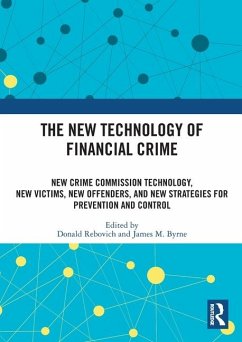The New Technology of Financial Crime
New Crime Commission Technology, New Victims, New Offenders, and New Strategies for Prevention and Control
Herausgeber: Rebovich, Donald; Byrne, James M.
The New Technology of Financial Crime
New Crime Commission Technology, New Victims, New Offenders, and New Strategies for Prevention and Control
Herausgeber: Rebovich, Donald; Byrne, James M.
- Broschiertes Buch
- Merkliste
- Auf die Merkliste
- Bewerten Bewerten
- Teilen
- Produkt teilen
- Produkterinnerung
- Produkterinnerung
Financial crime is a trillion-dollar industry that is likely to continue to grow exponentially unless new strategies of prevention and control can be developed. This book covers a wide range of topics related to financial crime commission, victimization, prevention, and control.
Andere Kunden interessierten sich auch für
![Lawyers and the Proceeds of Crime Lawyers and the Proceeds of Crime]() Katie BensonLawyers and the Proceeds of Crime186,99 €
Katie BensonLawyers and the Proceeds of Crime186,99 €![The Private Sector and Organized Crime The Private Sector and Organized Crime]() The Private Sector and Organized Crime56,99 €
The Private Sector and Organized Crime56,99 €![The Private Sector and Organized Crime The Private Sector and Organized Crime]() The Private Sector and Organized Crime168,99 €
The Private Sector and Organized Crime168,99 €![State-Corporate Crime and the Commodification of Victimhood State-Corporate Crime and the Commodification of Victimhood]() Thomas MacManusState-Corporate Crime and the Commodification of Victimhood55,99 €
Thomas MacManusState-Corporate Crime and the Commodification of Victimhood55,99 €![The Crime of Maldevelopment The Crime of Maldevelopment]() María Laura BöhmThe Crime of Maldevelopment55,99 €
María Laura BöhmThe Crime of Maldevelopment55,99 €![The Costs of Crime and Justice The Costs of Crime and Justice]() Mark A. CohenThe Costs of Crime and Justice168,99 €
Mark A. CohenThe Costs of Crime and Justice168,99 €![The Crime of Maldevelopment The Crime of Maldevelopment]() María Laura BöhmThe Crime of Maldevelopment167,99 €
María Laura BöhmThe Crime of Maldevelopment167,99 €-
-
-
Financial crime is a trillion-dollar industry that is likely to continue to grow exponentially unless new strategies of prevention and control can be developed. This book covers a wide range of topics related to financial crime commission, victimization, prevention, and control.
Produktdetails
- Produktdetails
- Verlag: Routledge
- Seitenzahl: 254
- Erscheinungstermin: 27. Mai 2024
- Englisch
- Abmessung: 246mm x 174mm x 14mm
- Gewicht: 459g
- ISBN-13: 9781032192031
- ISBN-10: 1032192038
- Artikelnr.: 70338270
- Herstellerkennzeichnung
- Libri GmbH
- Europaallee 1
- 36244 Bad Hersfeld
- gpsr@libri.de
- Verlag: Routledge
- Seitenzahl: 254
- Erscheinungstermin: 27. Mai 2024
- Englisch
- Abmessung: 246mm x 174mm x 14mm
- Gewicht: 459g
- ISBN-13: 9781032192031
- ISBN-10: 1032192038
- Artikelnr.: 70338270
- Herstellerkennzeichnung
- Libri GmbH
- Europaallee 1
- 36244 Bad Hersfeld
- gpsr@libri.de
Donald Rebovich, Ph.D., Distinguished Professor of Criminal Justice at Utica College, is the Executive Director of the Center for Identity Management & Information Protection (CIMIP). Prior to coming to Utica College, Dr Rebovich served as Research Director for the National White-Collar Crime Center (NW3C) & the American Prosecutors Research Institute of the National District Attorneys Association (NDAA). James M. Byrne, Ph.D., is a professor in the School of Criminology and Justice Studies at the University of Massachusetts Lowell. He is the Director of the Global Community Corrections Initiative (www.globcci.org) and Editor-in-Chief of the journal, Victims & Offenders. Dr Byrne is the co-editor, The Global Impact of the COVID-19 Pandemic on Institutional and Community Corrections (Routledge, 2021), and is currently completing a new book, The Technology Revolution in Criminal Justice: A Global Review (Routledge, forthcoming).
Introduction 1. The Dynamics of Business, Cybersecurity and
Cyber-Victimization: Foregrounding the Internal Guardian in Prevention 2.
Phishing Evolves: Analyzing the Enduring Cybercrime 3. Online Fraud
Victimization in China: A Case Study of Baidu Tieba 4. Interrelationship
between Bitcoin, Ransomware, and Terrorist Activities: Criminal Opportunity
Assessment via Cyber-Routine Activities Theoretical Framework 5. The Use of
Military Profiles in Romance Fraud Schemes 6. The Distillation of National
Crime Data into A Plan for Elderly Fraud Prevention: A Quantitative and
Qualitative Analysis of U.S. Postal Inspection Service Cases of Fraud
against the Elderly 7. Organized Crime as Financial Crime: The Nature of
Organized Crime as Reflected in Prosecutions and Research 8. Preventing
Identity Theft: Perspectives on Technological Solutions from Industry
Insiders 9. Forecasting Identity Theft Victims: Analyzing Characteristics
and Preventive Actions through Machine Learning Approaches 10. The
Identification of a Model Victim for Social Engineering: A Qualitative
Analysis
Cyber-Victimization: Foregrounding the Internal Guardian in Prevention 2.
Phishing Evolves: Analyzing the Enduring Cybercrime 3. Online Fraud
Victimization in China: A Case Study of Baidu Tieba 4. Interrelationship
between Bitcoin, Ransomware, and Terrorist Activities: Criminal Opportunity
Assessment via Cyber-Routine Activities Theoretical Framework 5. The Use of
Military Profiles in Romance Fraud Schemes 6. The Distillation of National
Crime Data into A Plan for Elderly Fraud Prevention: A Quantitative and
Qualitative Analysis of U.S. Postal Inspection Service Cases of Fraud
against the Elderly 7. Organized Crime as Financial Crime: The Nature of
Organized Crime as Reflected in Prosecutions and Research 8. Preventing
Identity Theft: Perspectives on Technological Solutions from Industry
Insiders 9. Forecasting Identity Theft Victims: Analyzing Characteristics
and Preventive Actions through Machine Learning Approaches 10. The
Identification of a Model Victim for Social Engineering: A Qualitative
Analysis
Introduction 1. The Dynamics of Business, Cybersecurity and
Cyber-Victimization: Foregrounding the Internal Guardian in Prevention 2.
Phishing Evolves: Analyzing the Enduring Cybercrime 3. Online Fraud
Victimization in China: A Case Study of Baidu Tieba 4. Interrelationship
between Bitcoin, Ransomware, and Terrorist Activities: Criminal Opportunity
Assessment via Cyber-Routine Activities Theoretical Framework 5. The Use of
Military Profiles in Romance Fraud Schemes 6. The Distillation of National
Crime Data into A Plan for Elderly Fraud Prevention: A Quantitative and
Qualitative Analysis of U.S. Postal Inspection Service Cases of Fraud
against the Elderly 7. Organized Crime as Financial Crime: The Nature of
Organized Crime as Reflected in Prosecutions and Research 8. Preventing
Identity Theft: Perspectives on Technological Solutions from Industry
Insiders 9. Forecasting Identity Theft Victims: Analyzing Characteristics
and Preventive Actions through Machine Learning Approaches 10. The
Identification of a Model Victim for Social Engineering: A Qualitative
Analysis
Cyber-Victimization: Foregrounding the Internal Guardian in Prevention 2.
Phishing Evolves: Analyzing the Enduring Cybercrime 3. Online Fraud
Victimization in China: A Case Study of Baidu Tieba 4. Interrelationship
between Bitcoin, Ransomware, and Terrorist Activities: Criminal Opportunity
Assessment via Cyber-Routine Activities Theoretical Framework 5. The Use of
Military Profiles in Romance Fraud Schemes 6. The Distillation of National
Crime Data into A Plan for Elderly Fraud Prevention: A Quantitative and
Qualitative Analysis of U.S. Postal Inspection Service Cases of Fraud
against the Elderly 7. Organized Crime as Financial Crime: The Nature of
Organized Crime as Reflected in Prosecutions and Research 8. Preventing
Identity Theft: Perspectives on Technological Solutions from Industry
Insiders 9. Forecasting Identity Theft Victims: Analyzing Characteristics
and Preventive Actions through Machine Learning Approaches 10. The
Identification of a Model Victim for Social Engineering: A Qualitative
Analysis









